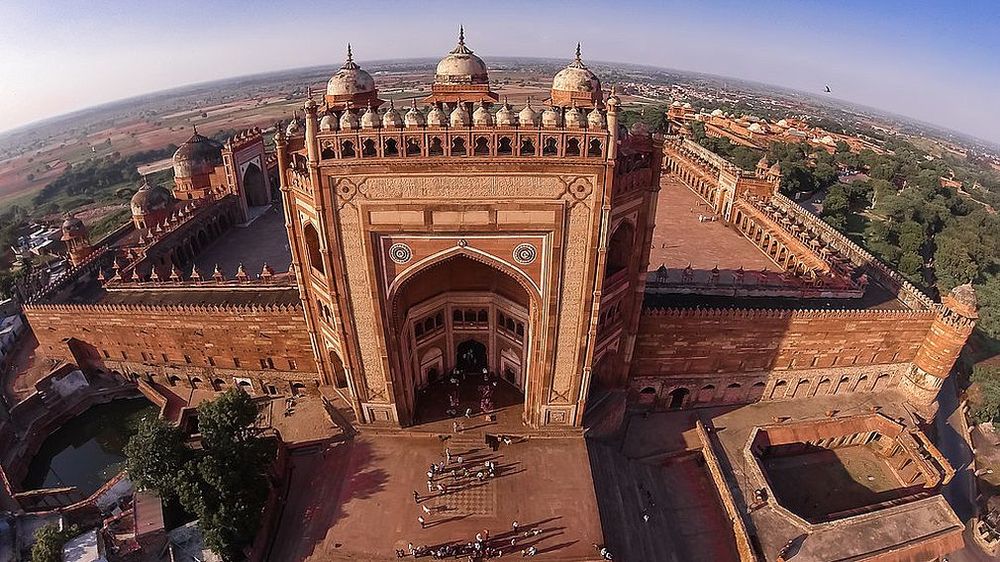Fatehpur Sikri was built by the Emperor Akbar in 1571. The work, supervised by Akbar himself, was completed in 1573. Fatehpur Sikri derives its name from the village of Sikri, which occupied the spot earlier. The prefix Fatehpur, or ‘City of Victory’, was added in 1573 after Akbar’s conquest of Gujarat. The city comprised of a series of palaces, public buildings and mosques, as well as the living areas of the court, the army, servants of the king, and for his people.
It was built on a rocky plateau, near an artificial lake, and the monuments were constructed of red sandstone, with a blend of Hindu, Persian, and Indo-Muslim traditions. In 1585, however, Akbar abandoned Fatehpur Sikri to fight against the Afghan tribes, and chose a new capital. Though it had a short life of splendor, Fatehpur Sikri has remained till date as one of the most magnificent and well-preserved heritage sites in India.
Why is Fatehpur Sikri the city that an emperor forgot ?
Akbar chose to build his city in the village of Sikri out of reverence for Sheikh Salim, a religious mystic of the Chisty order, who prophesied that he would have three sons at that site. Akbar moved his pregnant wife to Sikri where she had two sons. In thanksgiving, Akbar decided to build an imperial mosque and palace at the village of Sikri. After 1573, it was regarded as the capital of the Mughal Empire. However, after the city was abandoned by Akbar in 1585 to fight a campaign in the Punjab, it seems to have declined just rapidly. By 1610, it was completely abandoned. The reason for the sudden decline of the city is usually given as the failure of the water supply system. However, the real reason may have been the emperor’s loss of interest, since he had built it on a whim in the first place.
Why are the Diwan-I-Aam and Diwan-I-Khas important buildings in Fatehpur Sikri?
Fatehpur Sikri is regarded as Emperor Akbar’s crowning architectural legacy. His creative and aesthetic impulses have found exquisite expression in its numerous palaces, halls, and masjids. The Diwan-I-Aam is the first enclosure of the palace as one enters. It is a vast courtyard that was used by Emperor Akbar for the daily public audience called ‘Jharokha’ It was also used to dispense justice. The Diwan-I-Aam gave access to a second magnificent enclosure that is called the Diwan-I-Khas.
This is undoubtedly the finest building in Fatehpur Sikri, and was used for the private audiences and other court activities. This inspiring chamber is dominated by a massive carved pillar that has thirty six brackets supporting a balcony for Akbar. If you ever get a chance to visit Fatehpur Sikri, let your imagination soar, and in your mind’s eye you will see Akbar is granted audience to his subjects, and dispensing justice.
Star Fact
Panch Mahal
The Panch Mahal is a five-floored pillared pavilion in Fatehpur Sikri. This extraordinary building was called badgir or wind tower, because its innumerable pillars on all the floors allowed the breeze to flow through it, so that it was always cool, even in summer. Built on the pattern of a Buddhist Temple, Panch Mahal was basically a pleasure palace of Emperor Akbar.
Jodha Bai’s Palace
The palace of Jodha Bai, the Rajput Queen of the emperor is the largest and most important part of Akbar’s imperial harem at Fatehpur Sikri. The palace consists of a rectangular block, with a single magnificent gateway to the eastern side, which was protected by guard rooms. Hindu motifs like swans, parrots, elephants and lotuses adorn the interior.
























